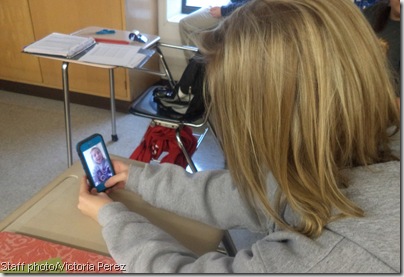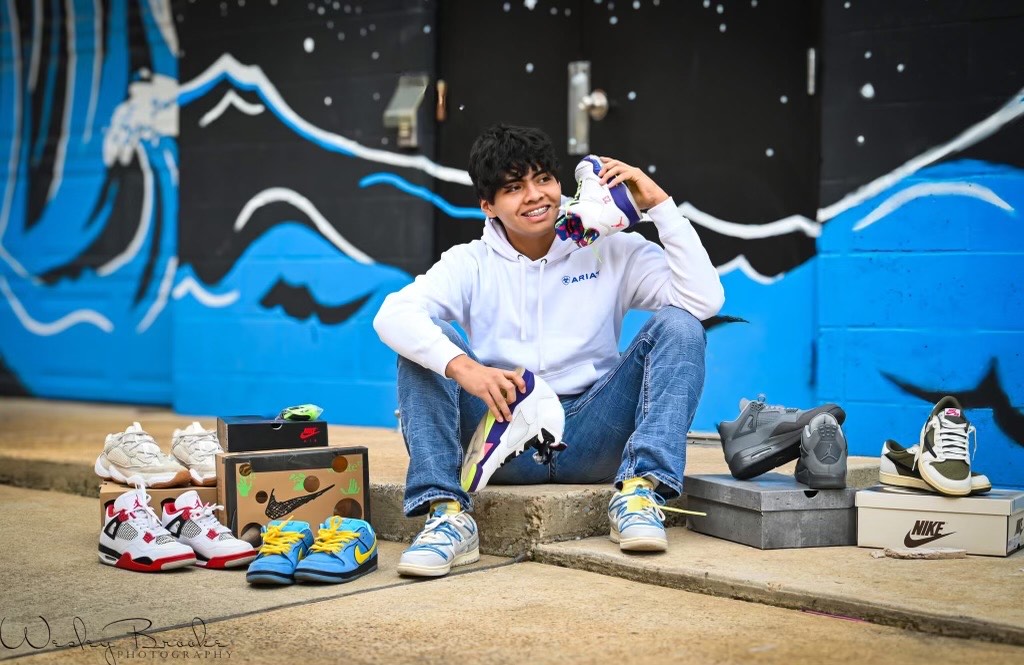Courtney Garrett makes a video selfie using Snapchat.
VICTORIA PEREZ – Hoof Prints Staff
One picture can change people’s perception of you. One person can have the power to stain your reputation, and one mistake can change everything.
Social media is everywhere. On phones, tablets, and computers. With a click of button or mouse, we can express our feelings, communicate with others, and share our experiences. Although social media can be used for positive things, students are discovering the hard way that it can also be used to stain reputations and change people negatively.
First it was Facebook, then Twitter, Instagram, and Vine. Now, the new trending app among teenagers is Snapchat. Snapchat is a photo messaging application that allows users to send and receive pictures and videos for a selected time range of one to ten seconds. After the snap is viewed, it is hidden for the recipient’s device and deleted from the Snapchat server.
Despite the fact that Snapchat creators, Evan Spiegel and Bobby Murphy deny this, many say that the original purpose for Snapchat was to facilitate the sending and receiving of inappropriate pictures. This style of communication is known by teens as sexting.
“It’s an impulsive choice.” BIC teacher, Marti Peel said, “They don’t think about the consequences, how it can affect them later on. They don’t realize that once your reputation is stained, it’s very hard to recover.”
In an informal survey, approximately 13% of BIC students who use snapchat believe this app is a safe way to send improper photos. Although Snapchat now notifies the sender if the recipient takes a screenshot, there are several ways for users to bypass Snapchat’s restrictions and notifications. For example, a picture can be taken with another device, the notification function can be disabled, or the app can be run through an emulator.
As of May 2012, approximately 25 images are sent per second using only the Snapchat app. Roughly about 52% of BIC students who participated in an informal survey use or have used Snapchat. Out of those students, 10% admitted to sending inappropriate pictures and 23% claimed they have received inappropriate pictures as well solely through this easily accessible cellphone app.
“I worry that teens are so smart and familiar with technology but still too immature to make the best choices, especially if being pressured by others to comply to post things they know in their hearts they shouldn’t post. That is a bad mix with the potential to destroy someone’s character and even create a criminal record if caught with graphic pictures on a device.” BIC principal Randy Rose said.
As the new features of Snapchat are introduced, so are new dangers. Snapchat developers have now added a video feature that will allow users to record a video lasting up to ten seconds. Although they “disappear” once they are viewed, there is still the risk of another device being used to capture these private videos.
“It gives teenagers too much freedom when they already make impulsive decisions. Teenagers just do not protect their reputations.” said Peel.
Although Snapchat is the main method teens use to send and receive inappropriate pictures, regular methods such as texting or video communication are still ways that explicit pictures are sent among teens. Texting especially is a common way that teens communicate inappropriately as one student describes.
“It was stupid. I really shouldn’t of done it and I really regret it now.” an anonymous BIC student said, “I just let myself be pressured by someone who wasn’t even worth it.”







